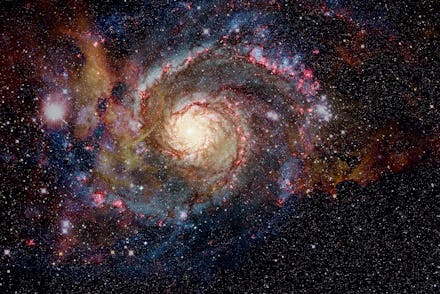Scientists are studying this “Godzilla” galaxy to try and figure out how it got so huge

When you think of galaxies in outer space, one of the most intriguing things to ponder is how big they are and how tiny humans are in comparison. It's one of those things that's difficult to wrap your head around, as you float around on a space rock that feels infinitesimally small in the major scheme of things. Our own galaxy is no slouch in the size arena, given that our solar system alone is quite large. But researchers at the University of Kentucky have been hard at work studying perhaps one of the biggest ever seen: UGC 2885. It's a colossal galaxy with a supermassive black hole at the center, and the largest in our local universe so far, clocking in at 2.5 times wider than the Milky Way with about 10 times more stars. NASA even gave it a nickname: the "Godzilla galaxy."
University of Kentucky astronomer Benne Holwerda has been studying the galaxy for some time now. He presented some of his team's findings on Sunday (January 5) at the 235th meeting of the American Astronomical Society in Hawaii.
"How it got so big is something we don't quite know yet," Holwerda said of the galaxy. "It's as big as you can make a disk galaxy without hitting anything else in space." Holwerda is far from the first person to explore this particular galaxy, as it's been under investigation for years, with its rotation measured by astronomer Vera Rubin back in the '80s. With that in mind, Holwerda's personal nickname for the "Godzilla" galaxy is "Rubin."
"Vera Rubin was a wonderful person, respected and admired by many in the astronomical community. She was unfailingly encouraging of young scientists. This has been a recurring theme of stories about her that I have heard. But also something I have experienced myself," Holwerda said of the astronomer herself in a tweet.
Using Holwerda's data, researchers at the Space Telescope Science Institute (STSCI) in Baltimore made a color image showing off what the team had come up with.
The massive galaxy is relatively isolated where it's currently located in the outer reaches of space, though researchers still aren't totally sure how the other galaxies previously surrounding it were cleared out. One possibility is that it simply absorbed other galaxies around it. There are various ways that galaxies can grow larger, and absorption is one acceptable theory, but it's unclear at this time what actually happened with this one. Many larger galaxies have been proven to absorb smaller ones, in fact, over time, including our own Milky Way. But Holwerda doesn't believe that's the case for the Rubin galaxy.
It's not as if the Rubin galaxy is particularly "weird," either.
"We do see some similar sized spirals in the more distant Universe but they all seem to have recently had a big merger (these are the "super spirals"). Not UGC 2885. It is just neat and regular and huge," Holwerda said.
But he and his team are still hard at work trying to piece together additional reasoning and explanation for both its location and size. There's still a lot that neither Holwerda and NASA have no idea about when it comes to this gargantuan galaxy, but hopefully additional details come together in the near future. Chalk it up to another one of the many, many mysteries of space that researchers are doing their part to research.